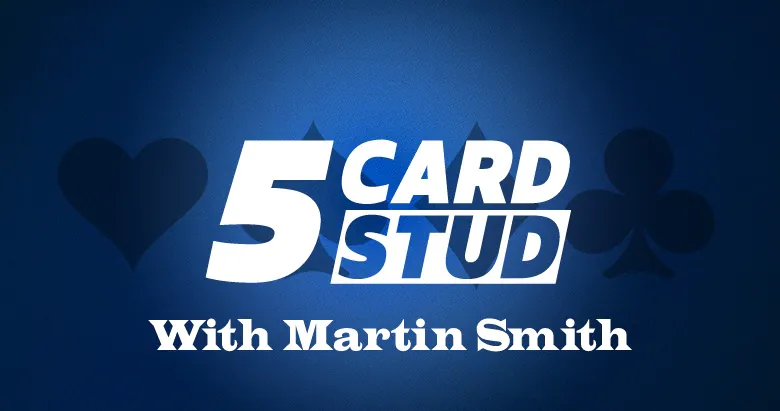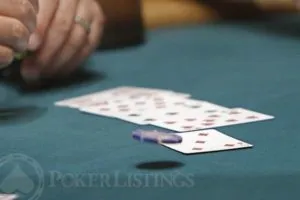How to Play 5 Card Stud


- Fact Checked by: PokerListings
- Last updated on: March 13, 2025 · 6 minutes to read
Five Card Stud Poker is one of the oldest poker variants that is still played today. This is the game played by Steve McQueen’s character in the movie The Cincinatti Kid (1965). In fact, if you see an old movie about the American Civil War or the old Wild West, there will often be a scene depicting this game being played in a saloon. Wild Bill Hickok was shot and killed while playing this game: legend has it that he was unable to take his usual seat with his back to the wall facing the door, and this meant that his assassin was able to approach without warning and shoot him in the back of the head at point blank range.
These days it’s probably not so important to watch your back while playing this game! It is a straightforward game and easy to learn.
The game is also known as “Open Poker.” Only the first card given to each player is dealt face down, the other four all appearing face up.
Ante Up!
To get the game started and to put money in the pot for the players to compete for, each player to be dealt into the hand will post an ante. This is a forced bet of a small, set amount. When all players have paid the ante, the dealer will pull all the antes into the middle of the table and start the deal.
For the purposes of this article I will use $1 as the size of the ante. This will help the reader understand the difference between the ante and the other bet sizes.
The Initial Deal
Starting from seat one, or the left of the dealer’s seat, each player will be given one card, face down, and then a second card, this time face up.
Stake.US Poker
T&Cs Apply | Play Responsibly | GambleAware
18+ | Play Responsibly | T&C Apply
First Betting Round (Second Street)
The first player to act is the one who has the lowest open card showing. If two people have cards of the same rank, the “lowest” suit will speak first – clubs being the lowest, followed by diamonds, then hearts, and finally spades.
That first person must make a forced bet, known as a “bring in.” The amount of the bring in is set, and it is small, usually a little bigger than the ante. For this example, we will say $2. If preferred, the player can bet a larger amount rather than the bring in. This larger amount is known as a complete bet and is also known as a small bet. A larger bet size will come into play on later streets of betting.
For this example, we will use $6 as the complete / small bet.
Once that first player has made their forced bet (usually only the bring in) the betting round continues in a clockwise direction.
Assuming the bring in bet size was chosen, the next player can opt to fold, call the bring in of $2, or complete the bet to $6. If no one completes the bet, each subsequent player still has those three options.
Once a player has completed the bet to $6, the next player can fold, call the $6, or raise to $12.
Subsequent players can fold or call or can continue to raise but only until there have been four bets – a total of $24 in the example. Once someone has raised to four bets the betting is regarded as “capped.” The other players then only have the options of folding or calling.
Once all players that have not folded have matched the bet amounts, the dealer can take in all the bets to the middle of the table and continue with the deal. If all players apart from one have folded their hands, the pot is given to that player and the hand is ended.
Dealing the Third Card
The dealer will “burn” a card – place the next card on the top of the deck face up in the middle of the table, to take no part in any player’s hand – and then deal a third card, face up, to each of the players that remain involved in the hand.
Second Betting Round (Third Street)
From this point on the betting is started by the player with the best hand showing. If two players are showing the same hand then the betting lead is with the person with the highest suit (in order spades – hearts – diamonds – clubs) of the highest card the players share. For example if Player A holds K 5 and player B holds K 5 then player A will go first because he holds the “highest” K.
The person with the betting lead can opt to “check” – make no bet – or bet the small bet of $6.
Note that until 2012 if any player had a pair, then the open bet can be either the small bet ($6 in this example) or a big bet ($12) at the choice of the bettor. But the Tournament Directors Association decided to end that rule from that point forward. It is possible you could find yourself playing in a card room where that rule is still in existence.
The betting round continues until all players have either folded or matched the largest bet, again capped at four bets or $24. Again, it is possible that all players except one release their hands, in which case the pot is awarded to the sole remaining participant and the hand is over.
Assuming there are still two or more players in the hand, the dealer will collect the bets in and proceed to the next deal.
Fourth Card
The dealer burns the next card on the top of the deck and deals a card face up to each player remaining in the hand.
Third Betting Round (Fourth Street)
The person with the best hand showing will now start the betting again. If s/he chooses to bet, the amount is now the big bet, or $12. The betting is still capped at four bets so the maximum investment for each player in this example is $48 on this betting street.
Once that betting round is over, if no one has yet won the pot by making a bet and seeing all their opponents fold, the dealer collects the bets into the pot and goes ahead with dealing the last card.
Fifth Card and Final Betting Round (Fifth Street or The River)
Again, after burning a card, the dealer will give a card, face up, to each player still in the hand.
This is followed by a final betting round of the same large amount, $12, and again capped at four bets.
Showdown!

Once the betting is all over the players reveal their hidden card and the pot is awarded to the player with the best poker hand according to the normal ranking of hands.
Five Card Stud – Basic Strategy
Five-Card Stud is a game of pairs and high cards. You want to make sure your starting hand strategy reflects this. Some quick takeaways to remember:
- Any pair is going to be playable on second street.
- Two cards that are higher than your opponents upcards are strong starters
- A hole card higher than your opponents’ upcards is good for seeing past second street
- If your upcard is higher than your opponent’s, you can try to take the pot down immediately.
- Hitting an open pair with this high card will likely result in you taking the hand right away.
- Remember opponents’ hands and folded cards to track outs and put other players on hands.
- If a player has been checking or calling along and just started betting, odds are he’s just paired his hole card. You’ll see this most often after someone spikes an ace or king on a later street.
- As in Stud High, beware the paired door card. A good percentage of the time your opponent just hit trips.
Click here to read more about poker strategy and poker pyschology
CoinPoker
T&Cs Apply | Play Responsibly | GambleAware
+18 / T & C apply / Play responsible
-
- 100% up to $2000
T&Cs Apply | Play Responsibly | GambleAware
18+ | Play Responsibly | T&C Apply
-
CoinPoker4.1
- 33% Weekly
- 150% up to 2000$
T&Cs Apply | Play Responsibly | GambleAware
+18 / T & C apply / Play responsible
-
Stake.US Poker4.3
- Rakeback 5%
- $55 Stake Cash + 260K Gold Coins
T&Cs Apply | Play Responsibly | GambleAware
18+ | Play Responsibly | T&C Apply
-
- 100% up to $1000
T&Cs Apply | Play Responsibly | GambleAware
T&Cs Apply | Play Responsibly | GambleAware
-
T&Cs Apply | Play Responsibly | GambleAware
18+ | T&Cs Apply | Play Responsibly | GambleAware




